Conceptualizing Niche–Regime Dynamics of Energy Transitions from a Political Economic Perspective: Insights from Community-Led Urban Solar in Seoul
Abstract
1. Introduction
2. A Theoretical Understanding of the Political Economic Perspective on Energy Transitions
2.1. Understanding Niche–Regime Dynamics in Socio-Technical Energy Transitions
2.2. The Political Economic Perspective on the Niche–Regime Dynamics
2.3. Towards an Integrated Framework
- (1)
- Global trends, political and economic ideologies, and public preferences: Manifested at the landscape level, political economy of socio-technical transitions can be approached in the domains of “interests”, “institutions”, and “ideas” [33]. This study departs from and contextualizes these domains into global trends, political and economic ideologies, and public preferences. The worldview on climate change (global trends, [18]), the Green Growth Vision in South Korea (political and economic ideologies, [18]), and low tariffs, clean air, energy sources, and community energy (public preferences, [34,35]) are some examples;
- (2)
- Political power structure, policy traditions, andgovernance approaches: Referencing the “horizontal understanding of power” and highlighting the dynamics of actors’ engagement with resources, structures, and systems through reinforcive, innovative, and transformative power [36,37], political power structure, policy traditions, and governance approaches are proposed in this study to understand such dynamics. Political power structure refers to, e.g., the relatively democratic nature of state power, political and industrial networks (in particular, the nature and intensity of government–industry linkages) [38,39,40], social networks between governments and civil society [12], and the role of political media (e.g., [29]); policy traditions include the “developmental state” in east Asia [41]; governance approaches refer to, e.g., authoritarian policy-making in China, technocratic policy-making in France [42,43], and participatory approaches in the UK [44], and key governance issues include public trust [12];
- (3)
- Physical availability of energy resources, national capacities for technological innovation, and national (energy) infrastructure development: These elements constitute the core building blocks of socio-technical systems transitions [45]. Energy self-reliant rates and power grid networks are some instances [39,46,47];
- (4)
- (5)
- Visioning and leadership, and national energy plans and policy frameworks: Visioning relates to visions of how energy transitions might unfold over time under the political processes, and the role that specific technologies could play in the process [49]; leadership refers to the ability of political and community leaders to articulate a vision and inspire people to act in order to achieve concrete results [50]; energy policy frameworks relate to clear policy objectives, policy frameworks, and specific policies such as RE feed-in tariff (REFIT) policies to guide technological searches [26,51]. Grounded by the theoretical articulation in “transitions management”, the long-term perspective of transitions is embedded in “goals” and “visions” defined in the processes of visioning, leadership, national energy plans, and policy frameworks [52].
3. Methodology
4. Case Contexts: Energy Challenges and Policy Responses in South Korea and Seoul
5. Findings and Discussions: Understanding Seoul’s Solar Niche Innovation from the Political Economic Perspective
5.1. Solar Has Been Supported as a Viable Energy Option in Both the National and Seoul Post-Fukushima Energy Strategies
- (1)
- Solar ranked top among all RE sources in Korea’s energy mix. In 2017, solar contributed 5.83 GW of Korea’s 15.7 GW RE capacity (Figure 3a) and 7056 GWh of electricity (1.3% of national electricity production).
- (2)
- Solar power in Korea has experienced a marked increase in recent years because of falling solar system costs and government policy support. The national solar installed capacity recorded a 70 fold increase from 81 MW in 2007 to 5.8 GW in 2017, with annual growth rates of over 40% in 2012–2015 before slowing to a growth rate of around 25–30% in 2016 and 2017 (Figure 3b).
- (3)
- Seoul’s solar deployment shows a roughly similar pattern to the national picture. Solar installed capacity increased from 6.7 MW in 2005 to 65 MW in 2016, with the highest annual growth of nearly 50% in 2013 (Figure 3c). Solar panels were, however, installed by less than 1% of the city’s 3.6 million households in 2017 [76], providing just 0.23% of Seoul’s electricity needs in 2017 despite Seoul’s ambitious solar target of 1 GW by 2022 (Table 2).
- (4)
- Solar energy is considered the most promising RE source mainly due to its suitability across the country [59]. South Korea is generally exposed to relatively high solar radiation, especially in the southern part of the Korea Peninsula. Seoul has a significant solar resource, with a monthly average daily solar radiation of 4.65 kWh/m2 compared to the national average of 4.01 kWh/m2 [59]. Approximately 30% of the 187 million m2 rooftops at a five-degree tilt in Seoul are also found suitable for solar deployment [77].
5.2. Seoul’s Model of Niche Innovation: Government-Empowered Community-Led Solar Developments
5.3. An Evaluation of the Niche Formation Process of Urban Solar in Seoul: Solar Niches Are Emerging, but the Magnitude of Energy Socio-Technical Regime Shift Has Been Limited
“At first, only a few stores in the local market installed solar panels. However, as that number grew to 20 and 30, we had a power of scale. Then, those stall owners who didn’t have solar panels installed feared of being isolated. They thought they might lose something by not being part of this new local social trend. In a sense, we made them feel like outsiders. So, without having to do any further persuasion, more and more merchants decided to install solar panels…I think about 50% of merchants have installed solar panels right now, and I hope the number will further increase”.(Interviewee 10)
- Fossil fuel/nuclear “lock-in” prevails in Seoul’s electricity sector. Solar is still a minor energy source in Seoul, representing merely 0.23% of Seoul’s electricity consumption in 2017. Solar households represented a tiny segment of Seoul. As of June 2017, 34,000 households were equipped with solar panels, equivalent to less than 1% of 3.6 million households [76].
- There is limited co-evolution of regulatory structures. KEPCO, the state-owned monopolistic utility that owns 92% of the nation’s total electricity generation capacity, has remained as a key regime actor for centralized fossil fuels and nuclear generation (Interviewees 4, 7b, 15, [28]).
- There is limited co-evolution of user practices. Although some residents in Seoul were attracted by the financial benefits of solar PV and its low up-front cost (as low as 70,000 KRW (approximately 63 USD) as of January 2019), they might be unwilling to pay for the replacement costs of inverters (170,000 KRW (approximately 152 USD)). Some householders in Sungdaegol have already idled or resold their solar systems in the second-hand markets to avoid paying the replacement costs though the systems were used for only several years. Despite the fact that the official figure of such cases is not available to the authors, at least some early solar adopters had an evidently low level of awareness of the need for system maintenance and low attachment to their solar systems (Interviewee 7b).
5.4. The Conducive Conditions for Niche Formation: From a Political Economic Perspective
5.4.1. Public Preferences for RE Introduced a Major Change in the Landscape
5.4.2. The Alignment of the National Green Growth Strategy and the Development Plans of Hi-Tech RE Clusters
5.4.3. Political Openness Enables a Bottom-Up Citizen-Centric Approach to Urban Solar in Seoul
5.4.4. Vertical and Horizontal Networks
5.5. The Inhibitive Conditions for Niche Formation: From a Political Economic Perspective
5.5.1. The “Developmental State” as the Dominant Economic Ideology Has Reinforced a Technological Lock-In Towards Nuclear
5.5.2. Incomplete Electricity Market Reforms and Regulatory Incompetence
“When this kind of change takes place with more companies and in more places, KEPCO will have no choice but to respond.”(Interviewee 7b, a community leader of the Sungdaegol solar community)
5.5.3. Swinging between Excessive Government Intervention and Inadequate State Action in Governing Solar Niche Developments
- (1)
- The policy target of the OLNPPP has focused on increasing decentralized solar installed capacity rather than centralized solar electricity generation in order to promote niche development through a citizen-centric and community-led approach [58];
- (2)
- Fewer policy priorities have been given by the Seoul government on grid enhancement to take up more RE from mini-PVs (Interviewee 7b). Under the partial electricity market reforms in South Korea, the national government provided insufficient incentives for the utilities to enhance grid capacity, nor did the Seoul government have the authority to provide such incentives; and
- (3)
- Seoul-type REFIT could only be offered to limited sizable solar PV projects instead of covering mini-PV projects under the existing grid infrastructure.
5.6. Understanding the Niche–Regime Dynamics across National, City, and Community Levels
6. Conclusions and Policy Implications
Author Contributions
Funding
Acknowledgments
Conflicts of Interest
Appendix A. List of Interviewees.
| Codes of Interviewees | Interviewees Background | Dates of Interviews | Duration of Interviews (Approximately) |
| 1. | An associate research fellow of the Korea Energy Economics Institute | 22 November 2017 | 1 h 30 min |
| 2. and 3. | A senior researcher and a senior manager of the Economy and Management Research Institute, KEPCO | 23 November 2017 | 1 h (group interview) |
| 4. | An assistant professor of the Department of Urban Administration, University of Seoul | 23 November 2017 | 2 h |
| 5. | A chairman of resident representatives of a residential property in Dongjak-gu, Seoul | 24 November 2017 | 30 min |
| 6. | An administration manager of a residential property in Dongjak-gu, Seoul | 24 November 2017 | 30 min |
| 7a. | Sungdaegol community representative A in Dongjak-gu, Seoul | 25 November 2017 | 2 h |
| 7b. | Same interview as 7a | 9 July 2018 | 2 h 30 min |
| 8. | Sungdaegol community representative B in Dongjak-gu, Seoul | 9 July 2018 | 1 h (group interview) |
| 9. | Sungdaegol community representative C in Dongjak-gu, Seoul | ||
| 10. | Sungdaegol merchants’ federation representative; community representative D in Dongjak-gu, Seoul | ||
| 11. | A director of a credit union in Dongjak-gu, Seoul | 9 July 2018 | 30 min |
| 12. | Chairman and President of a credit union in Dongjak-gu, Seoul | 9 July 2018 | 45 min |
| 13. | Representative of a solar company in Seoul | 9 July 2018 | 45 min |
| 14. | An assistant professor of the Corporate Course for Climate Change, Sejong University; Academic member A of the Implementation Committee, One Less Nuclear Power Plant | 10 July 2018 | 1 h 45 min |
| 15. | A professor of the Graduate School of Environmental Studies, Seoul National University; Academic member B of the Implementation Committee, One Less Nuclear Power Plant | 10 July 2018 | 1 h 15 min |
| 16. | A director of the Korea Federation for Environmental Movements | 10 July 2018 | 1 h 15 min |
| 17. | A researcher of the Institute of Green Transition, South Korea; Also a member of the Presidential Committee on Green Growth | 11 July 2018 | 40 min |
| 18. | A government official of the Green Energy Division, Seoul Metropolitan Government | 12 December 2019 | 1 h |
References
- Solarize NYC; NYC Solar Partnership: New York, NY, USA, 2019.
- Chung, E. Gov’t announces plan to take Seoul solar. Korea JoongAng Daily, 22 November 2017. [Google Scholar]
- Almirall, E.; Wareham, J.; Ratti, C.; Conesa, P.; Bria, F.; Gaviria, A.; Edmondson, A. Smart Cities at the Crossroads: New tensions in city transformation. Calif. Manag. Rev. 2016, 59, 141–152. [Google Scholar] [CrossRef]
- Jacobson, M.Z.; Cameron, M.; Hennessy, E.M.; Petkov, I.; Meyer, C.B.; Gambhir, T.K.; Maki, A.T.; Pfleeger, K.; Clonts, H.; McEvoy, A.; et al. 100% clean and renewable Wind, Water, and Sunlight (WWS) all-sector energy roadmaps for 53 towns and cities in North America. Sustain. Cities Soc. 2018, 42, 22–37. [Google Scholar] [CrossRef]
- Rohracher, H.; Späth, P. The Interplay of Urban Energy Policy and Socio-technical Transitions: The Eco-cities of Graz and Freiburg in Retrospect. Urban Stud. 2013, 51, 1415–1431. [Google Scholar] [CrossRef]
- Wolfram, M. Cities shaping grassroots niches for sustainability transitions: Conceptual reflections and an exploratory case study. J. Clean. Prod. 2018, 173, 11–23. [Google Scholar] [CrossRef]
- IEA. World Energy Outlook 2018; International Energy Agency: Paris, France, 2018. [Google Scholar]
- IPCC. Special Report: Global Warming of 1.5 °C; IPCC: Geneva, Switzerland, 2018. [Google Scholar]
- Geels, F.W. The multi-level perspective on sustainability transitions: Responses to seven criticisms. Environ. Innov. Soc. Transit. 2011, 1, 24–40. [Google Scholar] [CrossRef]
- Newell, P.; Phillips, J. Neoliberal energy transitions in the South: Kenyan experiences. Geoforum 2016, 74, 39–48. [Google Scholar] [CrossRef]
- Tian, D.; Ying, Q.; Han, B. Xinhua Headlines: “Yellow vest” movement points to a troubled France. Xinhuanews, 16 December 2018. [Google Scholar]
- Heo, I. The Political Economy of Policy Gridlock in South Korea: The Case of the Lee Myung?bak Government’s Green Growth Policy. Polit. Policy 2013, 41, 509–535. [Google Scholar] [CrossRef]
- Geels, F.W. Technological transitions as evolutionary reconfiguration processes: A multi-level perspective and a case-study. Res. Policy 2002, 31, 1257–1274. [Google Scholar] [CrossRef]
- Genus, A.; Coles, A.-M. Rethinking the multi-level perspective of technological transitions. Res. Policy 2008, 37, 1436–1445. [Google Scholar] [CrossRef]
- Smith, A.; Voß, J.-P.; Grin, J. Innovation studies and sustainability transitions: The allure of the multi-level perspective and its challenges. Res. Policy 2010, 39, 435–448. [Google Scholar] [CrossRef]
- Baker, L.; Burton, J. The politics of procurement and the low-carbon transition in South Africa. In Handbook of the International Political Economy of Energy and Natural Resources; Edward Elgar Publishing: Cheltenham, UK, 2018; pp. 91–106. [Google Scholar]
- Geels, F.W.; Schot, J. Typology of sociotechnical transition pathways. Res. Policy 2007, 36, 399–417. [Google Scholar] [CrossRef]
- Mah, D.N.-Y.; Van Der Vleuten, J.M.; Ip, J.C.-M.; Hills, P. Governing the transition of socio-technical systems: A case study of the development of smart grids in Korea. Energy Policy 2012, 45, 133–141. [Google Scholar] [CrossRef]
- Schot, J.; Geels, F.W. Strategic niche management and sustainable innovation journeys: Theory, findings, research agenda, and policy. Technol. Anal. Strat. Manag. 2008, 20, 537–554. [Google Scholar] [CrossRef]
- Klitkou, A.; Bolwig, S.; Hansen, T.; Wessberg, N. The role of lock-in mechanisms in transition processes: The case of energy for road transport. Environ. Innov. Soc. Transit. 2015, 16, 22–37. [Google Scholar] [CrossRef]
- Harborne, P.; Hendry, C.; Brown, J. The Development and Diffusion of Radical Technological Innovation: The Role of Bus Demonstration Projects in Commercializing Fuel Cell Technology. Technol. Anal. Strat. Manag. 2007, 19, 167–188. [Google Scholar] [CrossRef]
- Arent, D.; Arndt, C.; Miller, M.; Tarp, F.; Zinaman, O. (Eds.) The Political Economy of Clean Energy Ttransitions; WIDER Studies in Development Economics; Oxford University Press: Oxford, UK, 2017. [Google Scholar]
- Inderberg, T.H.J.; Tews, K.; Turner, B. Is there a Prosumer Pathway? Exploring household solar energy development in Germany, Norway, and the United Kingdom. Energy Res. Soc. Sci. 2018, 42, 258–269. [Google Scholar] [CrossRef]
- Kucharski, J.B.; Unesaki, H. An institutional analysis of the Japanese energy transition. Environ. Innov. Soc. Transit. 2018, 29, 126–143. [Google Scholar] [CrossRef]
- Mori, A. Socio-technical and political economy perspectives in the Chinese energy transition. Energy Res. Soc. Sci. 2018, 35, 28–36. [Google Scholar] [CrossRef]
- Baker, L.; Newell, P.; Phillips, J. The Political Economy of Energy Transitions: The Case of South Africa. New Polit. Econ. 2014, 19, 791–818. [Google Scholar] [CrossRef]
- Strunz, S.; Gawel, E.; Lehmann, P. The political economy of renewable energy policies in Germany and the EU. Util. Policy 2016, 42, 33–41. [Google Scholar] [CrossRef]
- Tsai, C.-M. The Political Economy of Restructuring the Electricity Sector in South Korea. Issues Stud. 2016, 52, 1650004. [Google Scholar] [CrossRef]
- Valentine, S.V.; Sovacool, B.K. The socio-political economy of nuclear power development in Japan and South Korea. Energy Policy 2010, 38, 7971–7979. [Google Scholar] [CrossRef]
- Unruh, G.C. Escaping carbon lock-in. Energy Policy 2002, 30, 317–325. [Google Scholar] [CrossRef]
- Padt, F.; Arts, B. (Eds.) Concepts of scale. In Scale-Sensitive Governance of the Environment; Wiley Blackwell: Chichester, UK; Hoboken, NJ, USA, 2014; pp. 1–26. [Google Scholar]
- Sovacool, B.K. The political economy of energy poverty: A review of key challenges. Energy Sustain. Dev. 2012, 16, 272–282. [Google Scholar] [CrossRef]
- Meadowcroft, J. Engaging with the politics of sustainability transitions. Environ. Innov. Soc. Transit. 2011, 1, 70–75. [Google Scholar] [CrossRef]
- Greenberg, M. Energy sources, public policy, and public preferences: Analysis of US national and site-specific data. Energy Policy 2009, 37, 3242–3249. [Google Scholar] [CrossRef]
- Petersen, J.-P. The application of municipal renewable energy policies at community level in Denmark: A taxonomy of implementation challenges. Sustain. Cities Soc. 2018, 38, 205–218. [Google Scholar] [CrossRef]
- Avelino, F. Power in Sustainability Transitions: Analysing power and (dis)empowerment in transformative change towards sustainability. Environ. Policy Gov. 2017, 27, 505–520. [Google Scholar] [CrossRef]
- Saculsan, P.G.; Mori, A. Why Developing Countries Go through an Unsustainable Energy Transition Pathway? The Case of the Philippines from a Political Economic Perspective. J. Sustain. Res. 2020, 2, 200012. [Google Scholar] [CrossRef]
- Kostka, G.; Hobbs, W. Embedded Interests and the Managerial Local State: The political economy of methanol fuel-switching in China. J. Contemp. China 2013, 22, 204–218. [Google Scholar] [CrossRef]
- Lundvall, B.-A. National Systems of Innovation: Towards a Theory of Innovation and Interactive Learning; Pinter Publishers: London, UK, 1992. [Google Scholar]
- Mah, D.N.-Y.; Hills, P. Collaborative Governance for Technological Innovation: A Comparative Case Study of Wind Energy in Xinjiang, Shanghai, and Guangdong. Environ. Plan. C Gov. Policy 2014, 32, 509–529. [Google Scholar] [CrossRef]
- Kim, E.-S. Sociotechnical Imaginaries and the Globalization of Converging Technology Policy: Technological Developmentalism in South Korea. Sci. Cult. 2017, 27, 175–197. [Google Scholar] [CrossRef]
- Grübler, A. The costs of the French nuclear scale-up: A case of negative learning by doing. Energy Policy 2010, 38, 5174–5188. [Google Scholar] [CrossRef]
- Hadjilambrinos, C. Understanding technology choice in electricity industries: A comparative study of France and Denmark. Energy Policy 2000, 28, 1111–1126. [Google Scholar] [CrossRef]
- Mah, D.N.-Y.; Hills, P. Participatory governance for energy policy-making: A case study of the UK nuclear consultation in 2007. Energy Policy 2014, 74, 340–351. [Google Scholar] [CrossRef]
- Geels, F.W. From sectoral systems of innovation to socio-technical systems: Insights about dynamics and change from sociology and institutional theory. Res. Policy 2004, 33, 897–920. [Google Scholar] [CrossRef]
- Heiskanen, E.; Matschoss, K. Understanding the uneven diffusion of building-scale renewable energy systems: A review of household, local and country level factors in diverse European countries. Renew. Sustain. Energy Rev. 2017, 75, 580–591. [Google Scholar] [CrossRef]
- Schweizer, P.-J.; Renn, O.; Köck, W.; Bovet, J.; Benighaus, C.; Scheel, O.; Schröter, R. Public participation for infrastructure planning in the context of the German “Energiewende”. Util. Policy 2016, 43, 206–209. [Google Scholar] [CrossRef]
- Byrne, J.; Mun, Y.-M. Rethinking reform in the electricity sector: Power liberalisation or energy transformation? In Electricity Reform: Social and Environmental Challenges; Wamukonya, N., Ed.; UNEP-RISØ Centre: Roskilde, Denmark, 2003; pp. 49–76. [Google Scholar]
- Torvanger, A.; Meadowcroft, J. The political economy of technology support: Making decisions about carbon capture and storage and low carbon energy technologies. Glob. Environ. Chang. 2011, 21, 303–312. [Google Scholar] [CrossRef]
- Mah, D.N.-Y. Community solar energy initiatives in urban energy transitions: A comparative study of Foshan, China and Seoul, South Korea. Energy Res. Soc. Sci. 2019, 50, 129–142. [Google Scholar] [CrossRef]
- Quitzow, R. Dynamics of a policy-driven market: The co-evolution of technological innovation systems for solar photovoltaics in China and Germany. Environ. Innov. Soc. Transit. 2015, 17, 126–148. [Google Scholar] [CrossRef]
- Meadowcroft, J. Environmental political economy, technological transitions and the state. New Polit. Econ. 2005, 10, 479–498. [Google Scholar] [CrossRef]
- Miles, M.B.; Huberman, A.M. Qualitative Data Analysis: An Expanded Sourcebook, 2nd ed.; Huberman, A.M., Ed.; Sage Publications: Thousand Oaks, CA, USA, 1994. [Google Scholar]
- KEEI. 2017 Energy Info Korea; Korea Energy Economics Institute: Ulsan, Korea, 2017. [Google Scholar]
- KEEI. 2018 Yearbook of Energy Statistics; Korea Energy Economics Institute: Ulsan, Korea, 2018. [Google Scholar]
- KEEI. 2018 Yearbook of Regional Energy Statistics; Korea Energy Economics Institute: Ulsan, Korea, 2018. [Google Scholar]
- WNA. World Nuclear Performance Report 2018; World Nuclear Association: London, UK, 2018. [Google Scholar]
- Dong, J.I.; Jeong, E.T. New Renewable Energy: One Less Nuclear Power Plant. 2018. Available online: https://seoulsolution.kr/print/3363 (accessed on 27 November 2018).
- Alsharif, M.H.; Kim, J.; Kim, J.H. Opportunities and Challenges of Solar and Wind Energy in South Korea: A Review. Sustainability 2018, 10, 1822. [Google Scholar] [CrossRef]
- Seoul Metropolitan Government. Seoul Statistical Yearbook 2018; Seoul Metropolitan Government: Seoul, Korea, 2018.
- Shin, J.-H. Korea to continue to go nuclear-free despite Taiwan’s pro-nuclear move. The Korea Herald, 26 November 2018. [Google Scholar]
- WNA. Nuclear Power in South Korea; World Nuclear Association: London, UK, 2018; Available online: http://www.world-nuclear.org/information-library/country-profiles/countries-o-s/south-korea.aspx (accessed on 9 November 2018).
- Joo, Y.-M. Megacity Seoul: Urbanization and the Development of Modern South Korea; Routledge: London, UK, 2018. [Google Scholar]
- Kim, H. A Community Energy Transition Model for Urban Areas: The Energy Self-Reliant Village Program in Seoul, South Korea. Sustainability 2017, 9, 1260. [Google Scholar] [CrossRef]
- IEA. IEA Atlas of Energy. Available online: http://energyatlas.iea.org/ (accessed on 23 January 2019).
- MOTIE. The 8th Basic Plan for Long-term Electricity Supply and Demand (2017–2031); The Ministry of Trade, Industry and Energy (MOTIE): Sejong, Korea, 2017.
- Korea Energy Agency. Feed-in Tariffs for New and Renewable Energy. 2015. Available online: http://www.energy.or.kr/renew_eng/new/renewable.aspx (accessed on 4 April 2018).
- Korea Energy Agency. Renewable Portfolio Standards (RPS). 2015. Available online: http://www.energy.or.kr/renew_eng/new/standards.aspx (accessed on 11 June 2018).
- MOTIE. Promotion of New and Renewable Energy. 2014. Available online: http://english.motie.go.kr/en/tp/alltopics/bbs/bbsView.do?bbs_cd_n=3&bbs_seq_n=19# (accessed on 29 November 2018).
- MOTIE. The 7th Basic Plan for Long-Term Electricity Supply and Demand (2015–2029); The Ministry of Trade, Industry and Energy (MOTIE): Sejong, Korea, 2016.
- The Public Deliberation Committee on Shin-Gori Nuclear Reactors No. 5 & 6. Results of Participatory Surveys for Public Deliberation on Shin-Gori Nuclear Reactors No. 5 & 6; The Public Deliberation Committee on Shin-Gori Nuclear Reactors No. 5 & 6: Seoul, Korea, 2017. [Google Scholar]
- Choi, H.-Y. South Korean government releases draft of plans to increase renewable energy use. Hankyoreh, 26 December 2017. [Google Scholar]
- Lee, C. Seoul announces 32.5 percent domestic greenhouse gas reduction goal. The Korea Herald, 24 July 2018. [Google Scholar]
- MOTIE. Full-Scale Implementation of FIT System for Small-Scale Solar Power Generation Companies. 2018. Available online: http://www.motie.go.kr/motie/ne/presse/press2/bbs/bbsView.do?bbs_cd_n=81&cate_n=1&bbs_seq_n=160642 (accessed on 9 November 2018).
- Lee, T. Translocal Relations & Climate Change in Asia. 2017. Available online: https://www.youtube.com/watch?time_continue=2&v=EFvNOWkbVyQ&feature=emb_logo (accessed on 26 March 2020).
- Kim, D.-S. Seoul City to expand support for installation of solar panels at homes. The Korea Herald, 14 August 2017. [Google Scholar]
- Byrne, J.; Taminiau, J.; Kurdgelashvili, L.; Kim, K.N. A review of the solar city concept and methods to assess rooftop solar electric potential, with an illustrative application to the city of Seoul. Renew. Sustain. Energy Rev. 2015, 41, 830–844. [Google Scholar] [CrossRef]
- Yun, S.-J. Seoul’s Energy Transition Experiment: One Less Nuclear Power Plant Initiative. In IEA Renewable Energy Working Party “Scaling-Up Renewables through Decentralised Energy Solutions”; International Energy Agency: Paris, France, 2017. [Google Scholar]
- Lee, J.-S.; Kim, J.W. The Factors of Local Energy Transition in the Seoul Metropolitan Government: The Case of Mini-PV Plants. Sustainability 2017, 9, 386. [Google Scholar] [CrossRef]
- Invest Korea. Investment Opportunities in Korea: New & Renewable Energy; Invest Korea: Seoul, Korea, 2017. [Google Scholar]
- Lee, J.S.; Kim, J.-W. South Korea’s urban green energy strategies: Policy framework and local responses under the green growth. Cities 2016, 54, 20–27. [Google Scholar] [CrossRef]
- Seoul Metropolitan Government. Joint Declaration of Regional Energy Conversion (Text in Korean). 2015. Available online: https://opengov.seoul.go.kr/press/6756934 (accessed on 4 April 2018).
- C40 Cities Climate Leadership Group. The Power of C40 Cities. 2019. Available online: https://www.c40.org/cities (accessed on 30 January 2019).
- Johnson, C. MITI and the Japanese Miracle: The Growth of Industrial Policy, 1925–1975; Stanford University Press: Stanford, CA, USA, 1982. [Google Scholar]
- Önis, Z.; Amsden, A.H.; Deyo, F.C.; Johnson, C.; Wade, R. The Logic of the Developmental State. Comp. Polit. 1991, 24, 109. [Google Scholar] [CrossRef]
- Caldentey, E.P. The Concept and Evolution of the Developmental State. Int. J. Polit. Econ. 2008, 37, 27–53. [Google Scholar] [CrossRef]
- Chu, Y.-W. The Asian Developmental State: Reexaminations and New Departures; Palgrave Macmillan: Basingstoke, UK, 2016. [Google Scholar]
- Chung, J.B.; Kim, E.-S. Public perception of energy transition in Korea: Nuclear power, climate change, and party preference. Energy Policy 2018, 116, 137–144. [Google Scholar] [CrossRef]
- Jasanoff, S.; Kim, S.-H. Containing the Atom: Sociotechnical Imaginaries and Nuclear Power in the United States and South Korea. Minerva 2009, 47, 119–146. [Google Scholar] [CrossRef]
- Hong, S.; Brook, B.W. A nuclear- to-gas transition in South Korea: Is it environmentally friendly or economically viable? Energy Policy 2018, 112, 67–73. [Google Scholar] [CrossRef]
- Kim, K.; Cho, Y. Estimation of power outage costs in the industrial sector of South Korea. Energy Policy 2017, 101, 236–245. [Google Scholar] [CrossRef]
- Yoon, J.-H.; Sim, K.-H. Why is South Korea’s renewable energy policy failing? A qualitative evaluation. Energy Policy 2015, 86, 369–379. [Google Scholar] [CrossRef]
- Green, J. Japan’s nuclear scandals and the Fukushima Disaster. 1 March 2012. Available online: http://archive.foe.org.au/sites/default/files/FUKUSHIMA_BRIEFING_MARCH_2012_0.pdf (accessed on 12 November 2018).
- Kim, S.; Kim, Y.; Shin, J.S. The Korean electricity market: Stuck in transition. In Evolution of Global Electricity Markets; Sioshansi, F.P., Ed.; Academic Press: Boston, MA, USA, 2013; pp. 679–713. [Google Scholar]
- Kim, S.-Y.; Mathews, J.A. Korea’s Greening Strategy: The role of smart microgrids. Asia-Pacific J. 2016, 14, 4987. [Google Scholar]
- Shin, J.-H. Korean tech giants under pressure to go renewable. The Korea Herald, 4 November 2018. [Google Scholar]
- KPX. KPX Membership Status. 2019. Available online: http://www.kpx.or.kr/www/contents.do?key=55 (accessed on 23 April 2020).
- Laes, E.; Gorissen, L.; Nevens, F. A Comparison of Energy Transition Governance in Germany, The Netherlands and the United Kingdom. Sustainability 2014, 6, 1129–1152. [Google Scholar] [CrossRef]
- Mah, D.N.-Y.; Wu, Y.-Y.; Hills, P.R. Explaining the role of incumbent utilities in sustainable energy transitions: A case study of the smart grid development in China. Energy Policy 2017, 109, 794–806. [Google Scholar] [CrossRef]
- Rizzo, A. Managing the energy transition in a tourism-driven economy: The case of Malta. Sustain. Cities Soc. 2017, 33, 126–133. [Google Scholar] [CrossRef]
- Fuller, S.; Bulkeley, H. Creating a low carbon zone in Brixton, London, UK. In An Urban Politics of Climate Change: Experimentation and the Governing of Socio-Technical Transitions; Bulkeley, H.A., Broto, V.C., Edwards, G.A.S., Eds.; Routledge: Abingdon, UK, 2014; pp. 199–218. [Google Scholar]
- HDB. HDB Calls First and Largest Solar Leasing Tender on Behalf of Multiple Agencies under EDB’s Solarnova Programme; Housing & Development Board: Singapore, 2015. [Google Scholar]
- Tilt, B. The Political Ecology of Pollution Enforcement in China: A Case from Sichuan’s Rural Industrial Sector. China Q. 2007, 192, 915–932. [Google Scholar] [CrossRef]
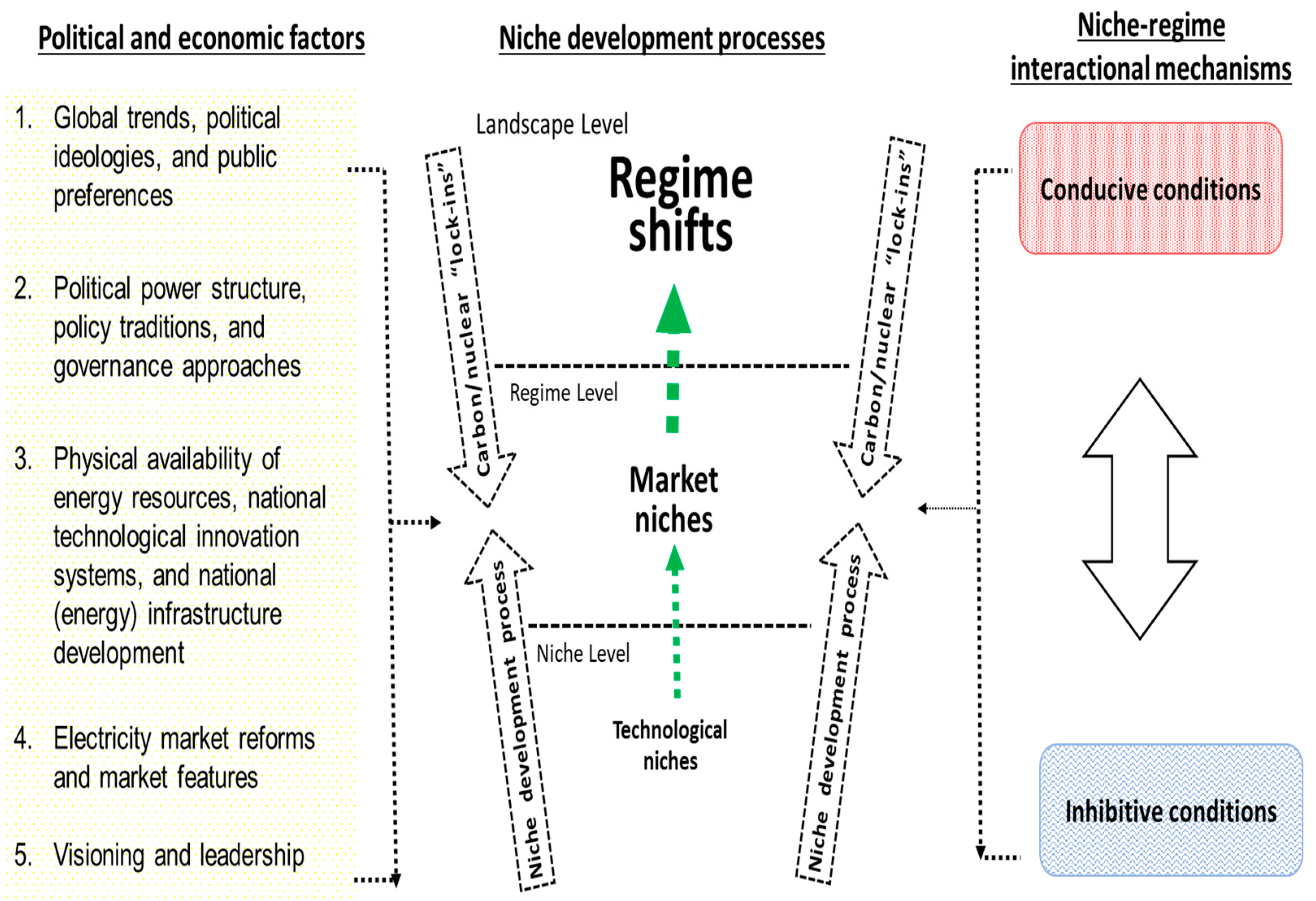
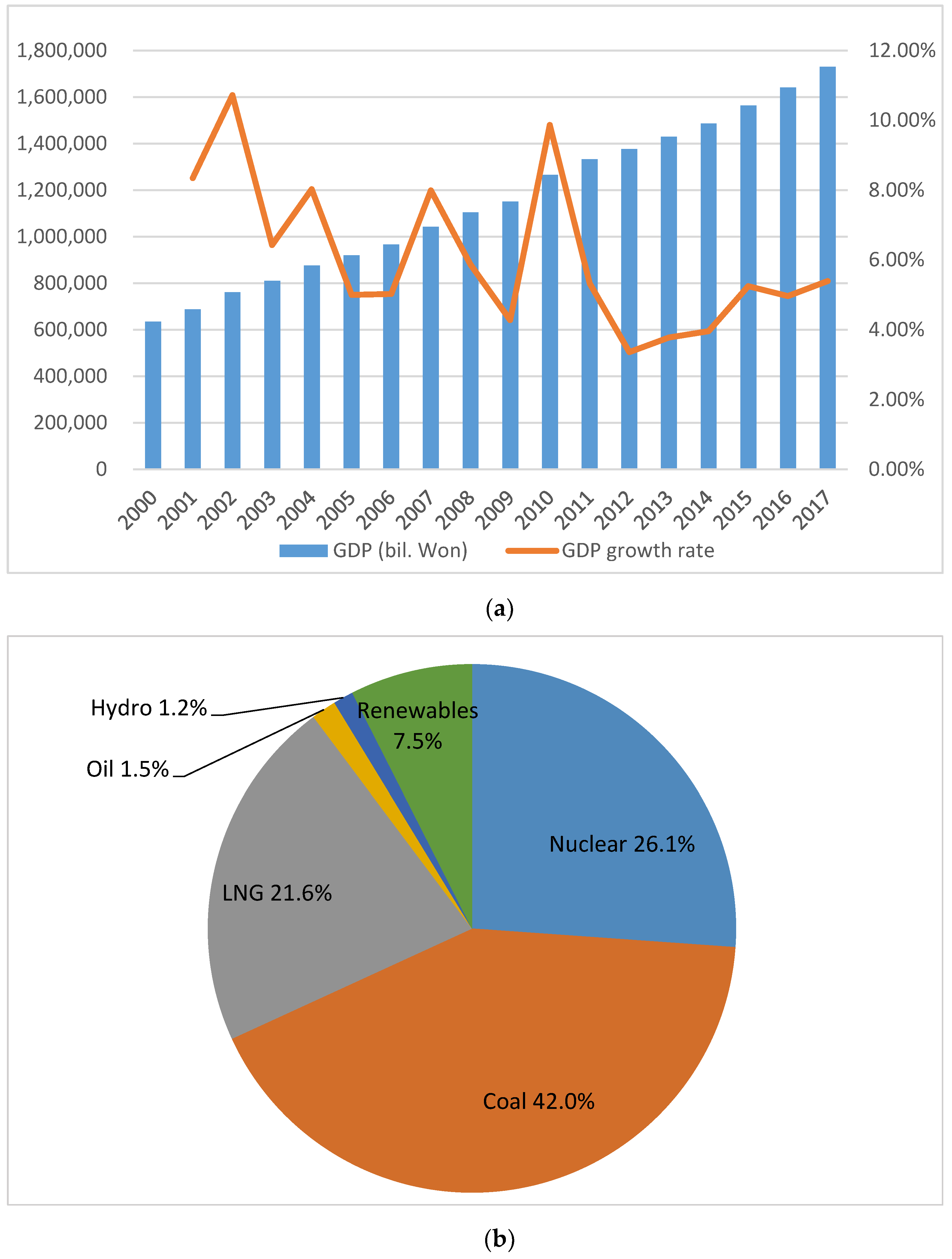

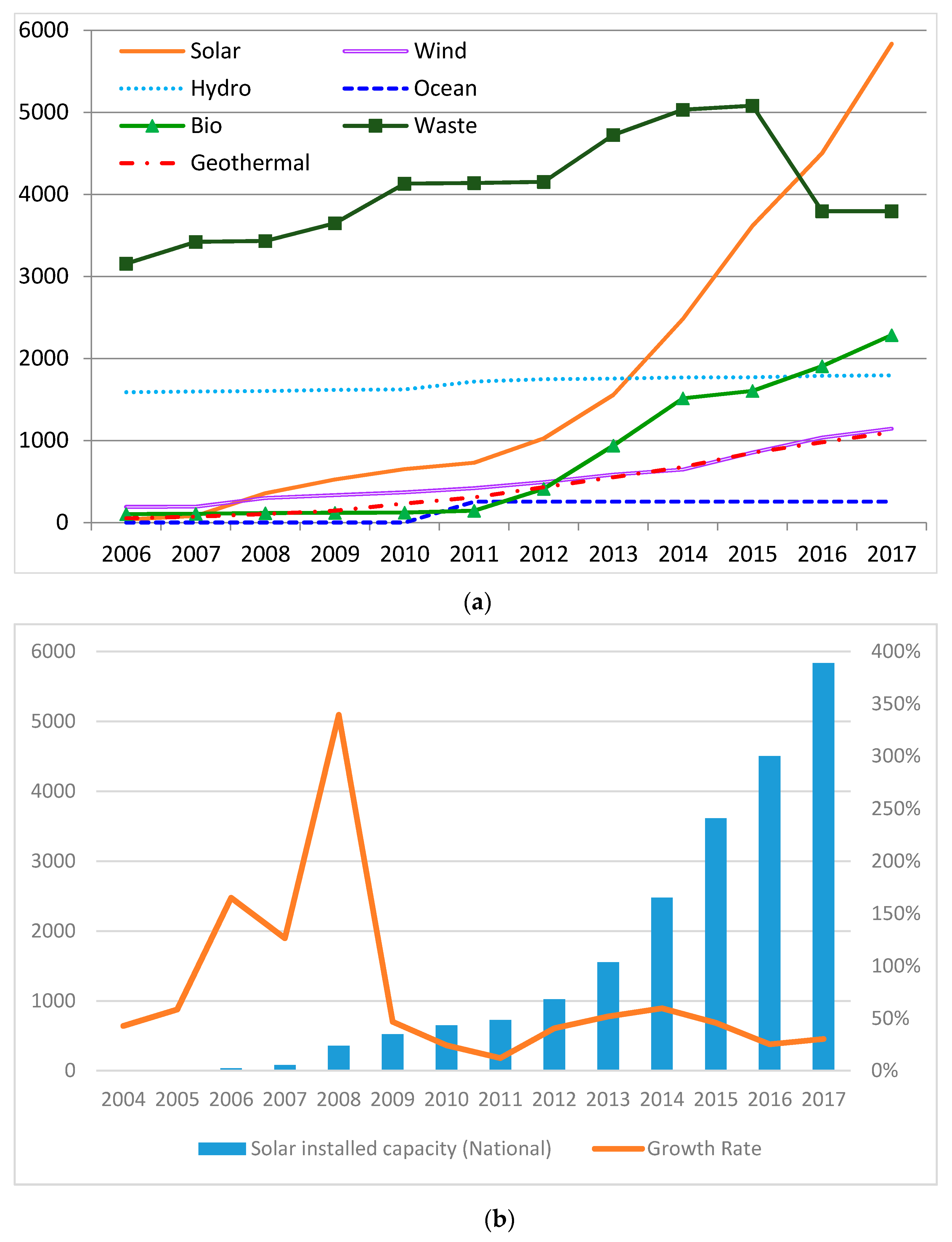
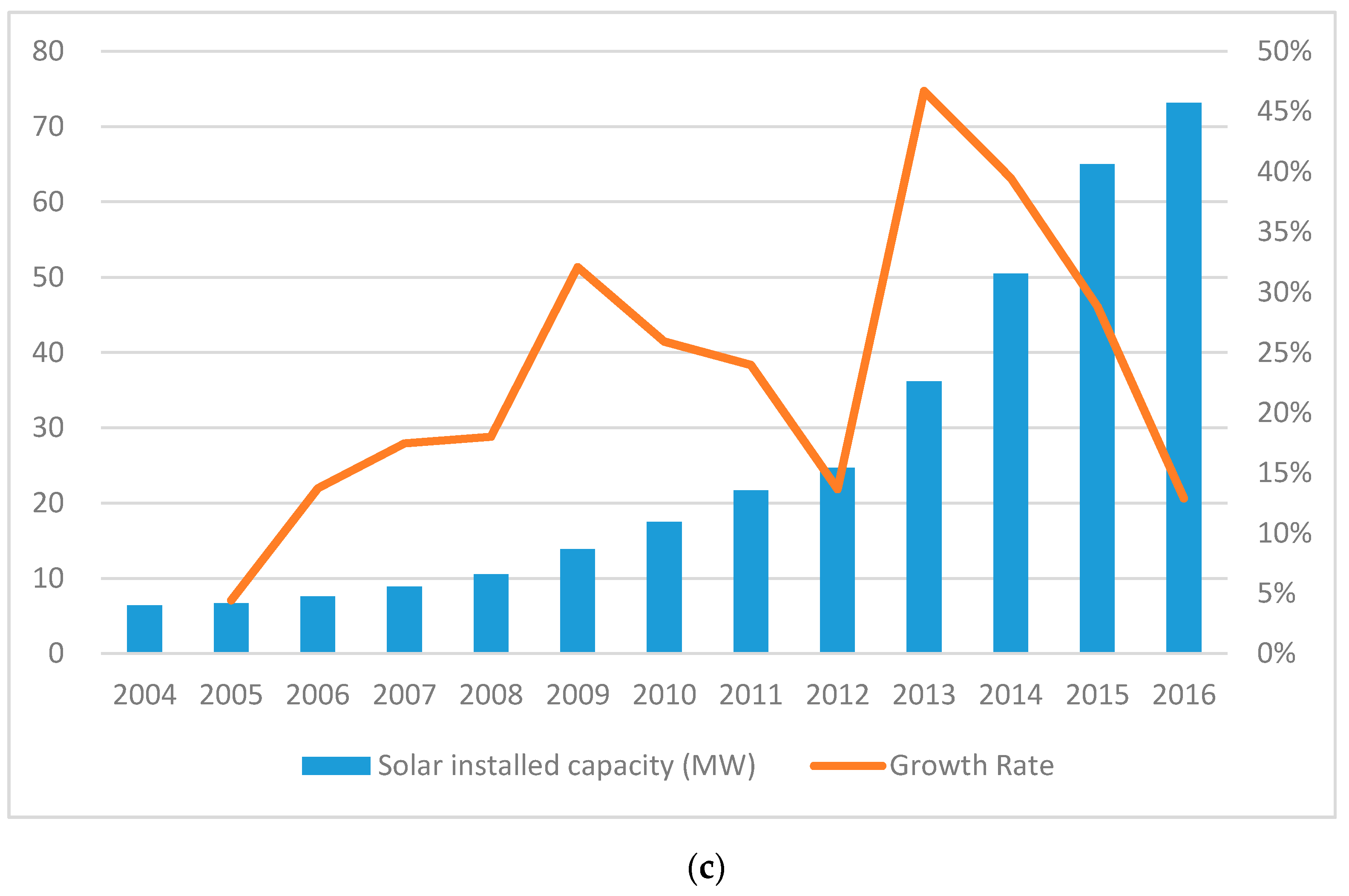
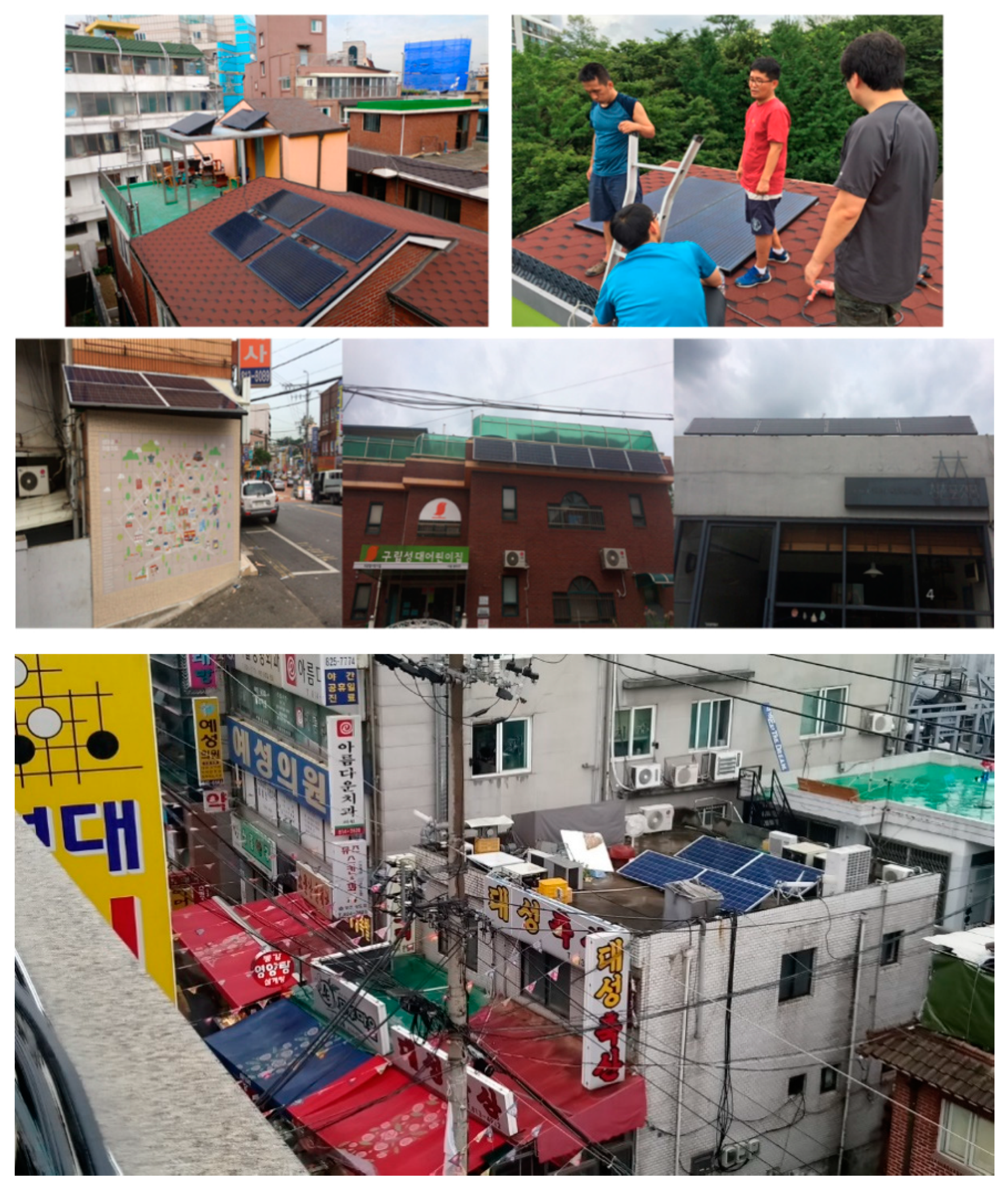
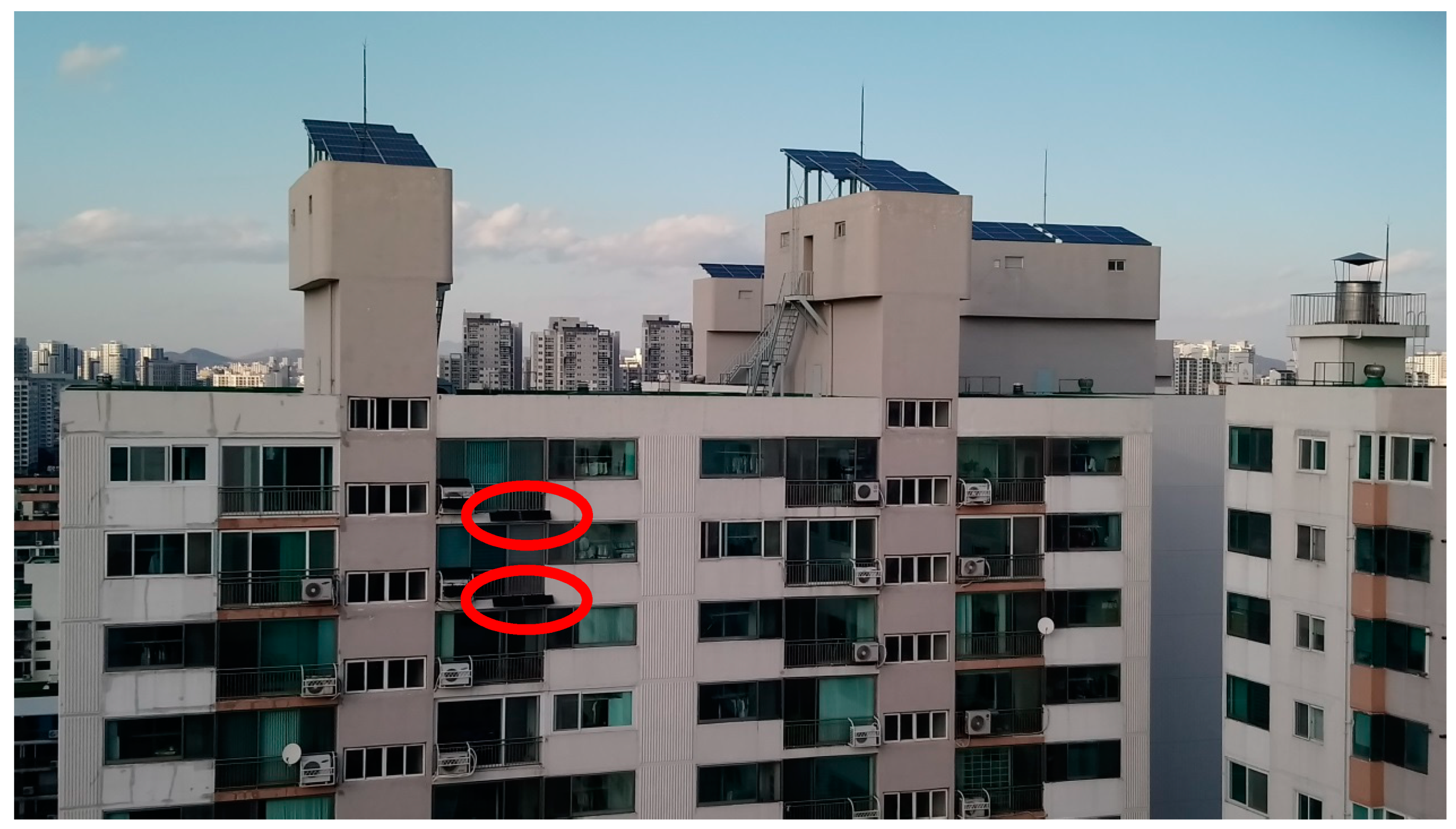
| Indicators | South Korea | Seoul | |
|---|---|---|---|
| Population | 51,422,507 | 10,124,579 (19.7%) | |
| GDP (current price; billion Won) | 1,553,948 | 339,796 (21.9%) | |
| Final energy consumption (1000 toe) | Coal Petroleum LNG and Towngas Electricity Heat energy Renewables Total | 33,360 (14.3%) 117,861 (50.4%) 24,053 (10.3%) 43,666 (18.7%) 2441 (1.0%) 12,520 (5.4%) 233,901 | 83 (0.6%) 6185 (41.3%) 4205 (28.1%) 3982 (26.6%) 261 (1.7%) 275 (1.8%) 14,990 |
| Electricity consumption (GWh) | 507,746 | 46,298 (9.1%) | |
| Electricity production (GWh) | 568,174 | 954 (0.17%) | |
| Electricity generation mix (GWh) | Coal Petroleum LNG Nuclear Hydro Solar Wind Ocean Bio Waste New energy | 238,799 (42.0%) 8663 (1.5%) 122,773 (21.6%) 148,427 (26.1%) 6995 (1.2%) 7056 (1.3%) 2169 (0.4%) 489 (0.1%) 7467 (1.3%) 23,867 (4.2%) 1469 (0.3%) | N/A 12 347 N/A 1.2 106 0.2 N/A 43 118 327 |
| Monthly average daily solar radiation (kWh/m2) | 4.01 (Relatively high) | 4.65 (Relatively high) | |
| Year | Energy Plan/Policy | Relevance to Renewable Energy | References |
|---|---|---|---|
| South Korea | |||
| 2012 | National RE policy reform |
| [67,68] |
| 2014 | Fourth Basic Plan for Technology Development, Application, and Deployment of New and Renewable Energy (2014–2035) |
| [69] |
| 2015 | National Seventh Basic Plan for Long-Term Electricity Supply and Demand (2015–2029) | Generation Mix Outlook:
| [70] |
| 2017 | National Public Deliberation on Shin-Gori Nuclear Reactors No. 5 and 6 |
| [71] |
| 2017 | National Eighth Basic Plan for Long-Term Electricity Supply and Demand (2017–2031) |
| [66] |
| 2017 | Renewable Energy 3020 Plan |
| [72] |
| 2018 | Greenhouse gas (GHG) reduction plan (revised) |
| [73] |
| 2018 | National feed-in tariff |
| [74] |
| Seoul | |||
| Since 2011 | One Less Nuclear Power Plant Policy (OLNPPP) Phase 1 (2011–2014) Phase 2 (2014–present) |
| [75] |
| 2017 | 2022 Solarcity Plan |
| [2] |
| Factors Affecting Niche–Regime Dynamics | Administrative Levels | Conducive Conditions | Inhibitive Conditions | Outcomes |
|---|---|---|---|---|
| 1. Global trends, political and economic ideologies, and public preferences | National |
|
|
|
| City |
|
|
| |
| Community (since the Fukushima accident) |
|
|
| |
| 2. Political power structure, policy traditions, and governance approaches | National |
|
|
|
| City |
|
|
| |
| Community |
|
|
| |
| 3. Physical availability of energy resources, national technological innovation systems, and national (energy) infrastructure development | National |
|
|
|
| City |
|
| ||
| Community |
| |||
| 4. Electricity market reforms and market features | National |
|
|
|
| City |
|
|
| |
| Community |
|
| ||
| 5. Visioning and leadership, and policy framework | National |
|
|
|
| City |
|
|
| |
| Community |
|
|
|
© 2020 by the authors. Licensee MDPI, Basel, Switzerland. This article is an open access article distributed under the terms and conditions of the Creative Commons Attribution (CC BY) license (http://creativecommons.org/licenses/by/4.0/).
Share and Cite
Mah, D.N.-y.; Cheung, D.M.-w. Conceptualizing Niche–Regime Dynamics of Energy Transitions from a Political Economic Perspective: Insights from Community-Led Urban Solar in Seoul. Sustainability 2020, 12, 4818. https://doi.org/10.3390/su12124818
Mah DN-y, Cheung DM-w. Conceptualizing Niche–Regime Dynamics of Energy Transitions from a Political Economic Perspective: Insights from Community-Led Urban Solar in Seoul. Sustainability. 2020; 12(12):4818. https://doi.org/10.3390/su12124818
Chicago/Turabian StyleMah, Daphne Ngar-yin, and Darren Man-wai Cheung. 2020. "Conceptualizing Niche–Regime Dynamics of Energy Transitions from a Political Economic Perspective: Insights from Community-Led Urban Solar in Seoul" Sustainability 12, no. 12: 4818. https://doi.org/10.3390/su12124818
APA StyleMah, D. N.-y., & Cheung, D. M.-w. (2020). Conceptualizing Niche–Regime Dynamics of Energy Transitions from a Political Economic Perspective: Insights from Community-Led Urban Solar in Seoul. Sustainability, 12(12), 4818. https://doi.org/10.3390/su12124818






